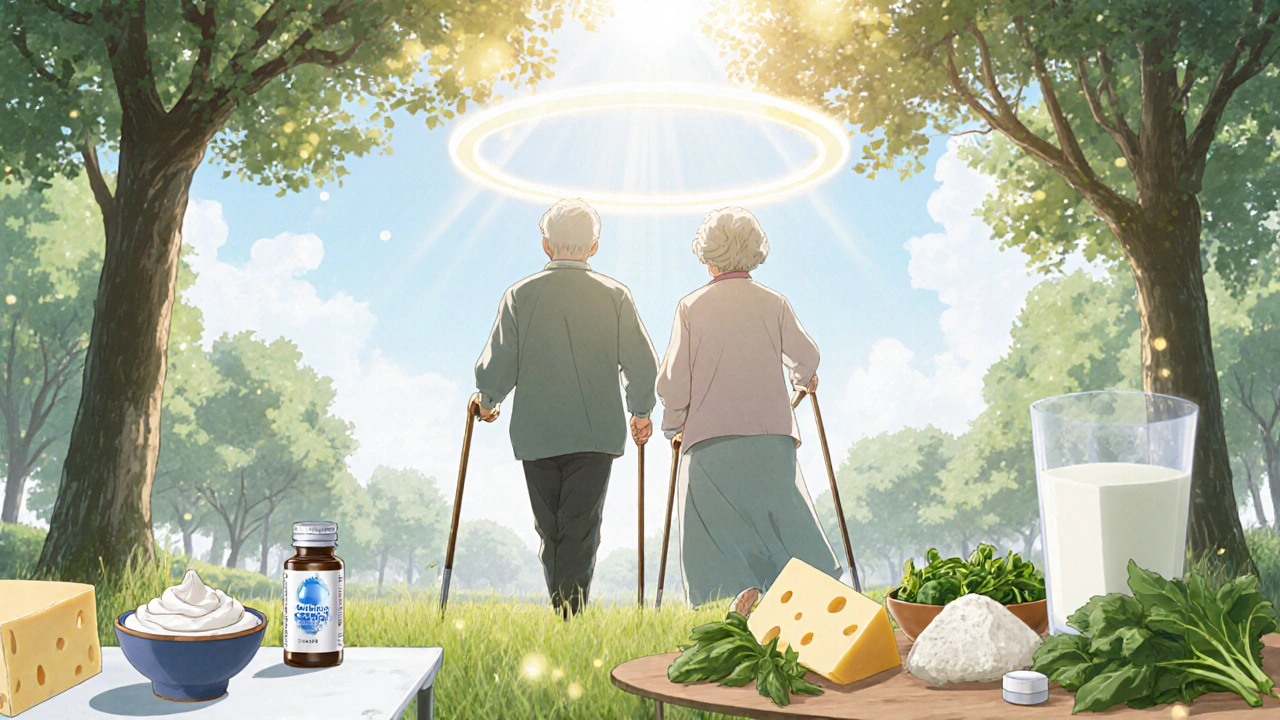Calcium & Vitamin D Calculator for Seniors
Based on guidelines for seniors over 65, this tool helps determine your daily calcium and vitamin D requirements based on your lifestyle and health factors.
Hypocalcemia in the Elderly is a medical condition where older adults have abnormally low levels of calcium in their blood. Calcium is vital for muscle function, nerve signaling, and bone strength, so a drop can quickly turn into serious health issues. This guide breaks down why it happens, what to look for, and how to keep calcium levels steady without over‑complicating things.
Key Takeaways
- Low blood calcium often stems from vitamin D shortage, kidney problems, or certain medicines.
- Watch for tingling, muscle cramps, and confusion - they’re common early warnings.
- Management blends diet changes, supplements, and treating the underlying cause.
- Regular blood tests and a balanced lifestyle can prevent most episodes.
Why Calcium Matters for Older Adults
Calcium does more than keep bones firm. It helps the heart beat regularly, aids blood clotting, and enables nerves to fire properly. In seniors, the body’s ability to absorb calcium drops, partly because skin produces less vitamin D when exposed to sunlight and kidneys become less efficient at converting vitamin D into its active form.
Common Causes of Low Calcium in Seniors
| Cause | How It Lowers Calcium | Typical Age Range |
|---|---|---|
| Vitamin D deficiency | Reduces intestinal calcium absorption | 65+ |
| Chronic kidney disease | Impaired activation of vitamin D; increased phosphate retention | 70+ |
| Parathyroid hormone (PTH) insufficiency | Fails to mobilize calcium from bone | 60+ |
| Medications (e.g., bisphosphonates, loop diuretics) | Alter calcium excretion or bone turnover | All ages, higher use in 65+ |
| Malnutrition or poor dietary intake | Insufficient calcium and vitamin D sources | 70+ |
| Pancreatitis | Calcium binds to fat saponified in the abdomen | Any adult |
Among these, hypocalcemia most often links back to vitamin D deficiency and chronic kidney disease, especially in people over 70.
Spotting the Symptoms Early
Calcium shortage shows up in nerves and muscles first. Look out for these signs:
- Neuromuscular irritability: tingling around lips, fingers, or toes (called paresthesia).
- Muscle cramps or spasms, especially in the back or calves.
- Facial grimacing known as Chvostek’s sign when tapping the facial nerve.
- Spontaneous twitching of the fingers (latent tetany).
- Confusion, memory lapses, or mood swings - the brain reacts quickly to electrolyte shifts.
- In severe cases, seizures or abnormal heart rhythms (QT prolongation on ECG).
Because older adults often attribute these feelings to aging, the condition can slip under the radar. Prompt testing is crucial.
How Doctors Diagnose Low Calcium
- Blood draw for total serum calcium and ionized calcium.
- Check vitamin D (25‑hydroxy) levels.
- Measure parathyroid hormone (PTH) to see if the glands are under‑producing.
- Assess kidney function (eGFR, serum creatinine) and phosphate levels.
- Review medications and dietary history.
Often, a single abnormal result prompts a deeper look. For example, low ionized calcium with normal total calcium suggests albumin issues rather than true deficiency.
Managing Hypocalcemia: A Step‑by‑Step Plan
1. Treat the Underlying Cause
Fixing vitamin D shortage is usually the first move. If kidney disease is the culprit, specialists may prescribe active vitamin D analogues (calcitriol) and manage phosphate levels.
2. Calcium Supplementation
- Oral calcium carbonate or calcium citrate - 500‑1000mg elemental calcium daily, split into two doses for better absorption.
- For severe cases, intravenous calcium gluconate under medical supervision.
3. Optimize VitaminD Intake
Standard recommendation: 800‑1000IU vitaminD3 daily for adults over 65, unless blood levels dictate a higher dose.
4. Adjust Medications
Review drugs that increase calcium loss (loop diuretics) or suppress bone turnover (bisphosphonates). A doctor may switch to a safer alternative or adjust the dosage.
5. Lifestyle Tweaks
- Encourage safe sunlight exposure - 10‑15minutes a few times a week.
- Include calcium‑rich foods: dairy (milk, cheese, yogurt), fortified plant milks, leafy greens (kale, bokchoy), and canned fish with bones.
- Stay hydrated but avoid excessive caffeine, which can increase calcium excretion.
6. Ongoing Monitoring
Re‑check serum calcium and vitaminD after 4-6weeks of treatment. Adjust doses based on trends, not a single reading.
Special Considerations for the Elderly
Older patients often juggle multiple health problems. Here are extra tips:
- Fall risk: Low calcium weakens bones, raising fracture chances. Pair calcium management with fall‑prevention exercises.
- Polypharmacy: Use a medication review tool to spot hidden calcium‑draining drugs.
- Renal function: Dose calcium and vitaminD carefully; too much can cause vascular calcification when kidneys are impaired.
- Gastrointestinal absorption: Conditions like celiac disease or chronic gastritis further limit calcium uptake - screen for them if symptoms persist.

Preventing Future Episodes
Prevention blends regular screening with sensible daily habits.
- Annual blood work for serum calcium, vitaminD, and kidney markers for anyone over 65.
- Dietary plan that meets at least 1200mg calcium and 800IU vitaminD.
- Physical activity - weight‑bearing exercises boost bone density and improve calcium metabolism.
- Educate caregivers about early warning signs: tingling, muscle cramps, or sudden confusion.
Quick Reference Checklist
- Ask about vitaminD intake and sun exposure.
- Review current meds for calcium‑affecting side effects.
- Order serum calcium, ionized calcium, 25‑OH vitaminD, PTH, and renal panel.
- Start calcium carbonate 500mg BID + vitaminD3 800IU daily (adjust as needed).
- Re‑test in 4‑6weeks and modify plan based on results.
Frequently Asked Questions
What blood calcium level is considered low for seniors?
A total serum calcium below 8.5mg/dL (2.12mmol/L) or ionized calcium under 4.6mg/dL (1.15mmol/L) is generally classified as hypocalcemia, but clinicians also consider albumin‑adjusted values and symptoms.
Can over‑the‑counter calcium supplements cause problems?
Yes, especially if taken in excess. Too much calcium can lead to kidney stones or, in people with kidney disease, vascular calcification. Always follow the recommended dose and have labs checked regularly.
Is sunlight enough to fix vitaminD deficiency?
Sunlight helps, but older skin makes less vitaminD. In most cases, a supplement of 800‑2000IU daily is needed, especially in winter or for those who stay indoors.
How quickly do symptoms improve after treatment?
Mild symptoms often ease within a few days of oral calcium and vitaminD. Severe cases treated with IV calcium may see relief within hours, but underlying causes still need long‑term management.
Should I avoid dairy if I have low calcium?
No. Dairy is a top source of calcium. Choose low‑fat options if you have heart concerns, but keep it in your diet unless lactose intolerant.


Wow, this guide really hits the heart! 🙌 As a supportive coach, I love how you break down the scary symptoms into bite‑size pieces – it makes the whole hypocalcemia puzzle feel solvable. Keep spreading the knowledge, because every senior deserves to feel strong and safe!
Honestly this article overcomplicates a simple calcium issue and throws way too many tables at us
While I respect the thoroughness, a concise checklist at the top would help readers quickly see what to do. For example, list the daily calcium target, vitamin D dosage, and the key labs to order. This small tweak could make the guide even more actionable for busy clinicians.
Behold, the drama of calcium-an elemental ballet where ions pirouette in the bloodstream, only to stumble when the sun's kiss wanes! One might say the body writes poetry in phosphates and vitamin D, yet neglect leads to a tragic silence of nerves and muscles. Let us not forget that every cramp is a whispered lament, every tingling a plea for balance. In the grand theater of geriatric care, we are both directors and audience, shaping the encore of health.
Esteemed readers, it is with utmost vigor that I implore you to adopt the recommended calcium regimen posthaste. The integration of sunlight exposure, dietary fortitude, and precise supplementation shall undoubtedly fortify the skeletal bastions of our elders. Let us proceed with enthusiasm and scholarly dedication.
I think the step‑by‑step plan is clear and helpful. Adding a quick reminder about checking medication labels could make it even better.
This looks like American nonsense, better health strategies exist elsewhere
Wow, another boring medical list. Who even cares about calcium when there are bigger problems? I’m tired of yet another ‘eat your dairy’ pep talk.
I hear you, and I want to say that navigating hypocalcemia in the golden years can feel like walking a tightrope over a sea of uncertainty. It’s easy to feel overwhelmed when the body sends signals like tingling fingers or sudden cramps, almost as if it’s shouting for help. The good news is that each of those signs is a clue, a beacon pointing us toward a manageable solution. By checking vitamin D levels regularly, we can catch deficiencies before they spiral into more serious problems. Pairing calcium‑rich foods with safe sunlight exposure creates a powerful duo, like two allies marching side by side. Remember, even a small glass of fortified plant milk each day can add a significant boost to daily calcium intake. For seniors on multiple medications, a simple medication review can uncover hidden culprits draining calcium stores. It’s also crucial to stay hydrated but avoid excessive caffeine, which can increase calcium loss through the kidneys. Engaging in light weight‑bearing exercises, such as short walks or gentle resistance bands, supports bone health and improves calcium metabolism. Consistency is key; rechecking labs every four to six weeks lets you fine‑tune dosages without over‑correcting. If you ever feel the confusion or mood swings returning, reconsider the dosage of vitamin D, as it directly influences neuronal stability. Sometimes, a modest increase of 200‑400 IU can make a world of difference in mental clarity. And never underestimate the power of a supportive caregiver who watches for early signs like muscle spasms. Their vigilance can prevent a full‑blown episode that might otherwise land you in the ER. Lastly, keep open communication with your healthcare team-share any new symptoms promptly so they can adjust treatment before complications arise. 😊
Don’t be fooled by the mainstream narrative that says a simple supplement will fix everything – there are hidden forces at play, from corporate pharma interests to shadowy labs pushing calcium pills for profit. The truth is buried under layers of red tape and selective studies, and we must stay vigilant, questioning every “official” recommendation.
As per established medical literature, the protocol outlined herein aligns with current clinical guidelines and therefore should be considered accurate and comprehensive.